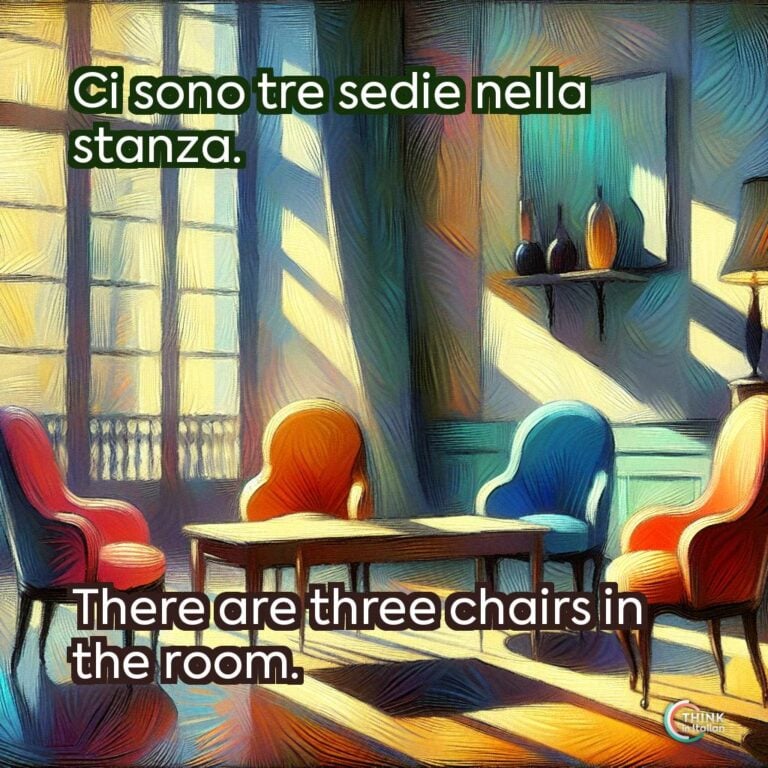“There is/There are” in Italian
The English expressions “there is” and “there are” have Italian equivalent counterparts that are formed and used in the same way: c’è and ci sono.
These expressions are relatively easy to master and very useful since they are used a lot in everyday conversation. Just like in English, they are used to indicate the presence of people, animals, or objects in a specific place.
Therefore, whether you need to use the singular or plural verb depends on the amount of items you are referring to, for instance:
C’è una festa in spiaggia stasera.
There is a party at the beach tonight.
Ci sono due mele in frigo.
There are two apples in the fridge.
“C’è” and “ci sono”
Use
These two Italian expressions are composed of the pronoun ci and the verb essere, conjugated either in the third person singular or plural.
What I find interesting is that, despite English and Italian are two relatively distant languages, the way they build this expression is the same: where in Italian we have ci, in English we have the literal translation “there”, and both use the verb “to be”.
It might seem obvious, but other Romance languages, like Spanish and French, behave completely differently. Also, do not forget that, in fact, the Italian ci is mainly used for places, being literally translated into English with “there”. For instance:
Mi piace Roma. Ci vado ogni anno.
I like Rome. I go there every year.
It probably makes sense to you for the plural ci sono, but I promise you the same occurs for the singular c’è. In fact, c’è is the abbreviation for ci è, where the first vowel was omitted and an apostrophe was used to produce a smoother pronunciation.
This orthographic phenomenon is very common in Italian, whenever one word ends with a vowel, and the following one starts with a vowel.
Conjugation
As you might have guessed already, c’è and ci sono can easily be used with all verb tenses. The pronoun does not change, while the verb essere is conjugated in different tenses.
Here I will write the most common indicative tenses and the corresponding conjugations:
| Presente (Present) | Imperfetto (Imperfect) | Passato prossimo (Present perfect) | Futuro semplice (Simple future) | |
| Singular | C’è | C’era | C’è stato | Ci sarà |
| Plural | Ci sono | C’erano | Ci sono stati/e | Ci saranno |
Examples
Let’s look at some sentences where the expressions c’è/ci sono are used:
Oggi c’è il sole.
Today it’s sunny (= There is the sun today)
Ci sono altri biscotti?
Are there more cookies?
Venti anni fa, c’era un campo di girasoli al posto di questo palazzo.
Twenty years ago, there used to be a sunflower field instead of this building.
In hotel non c’erano asciugamani.
There were no towels in the hotel.
C’è stato un problema con la stampante.
There has been a problem with the printer.
Ci sono stati problemi ieri a lavoro?
Were there any problems at work yesterday?
Of course, when using the passato prossimo remember that the past participle must agree in gender and number with the subject of the sentence, namely the item or items you are expressing the existence of. This happens because the auxiliary verb you are using is always essere.
Domani ci sarà una conferenza sul riscaldamento globale.
Tomorrow there will be a conference on global warming.
Stasera ci saranno molte persone al ristorante.
There will be many people at the restaurant tonight.
The Existence of Things
If you speak a language that has specific structures to express the existence of items, this topic will not surprise you. But if you speak a language like Russian, where this does not exist, I am sure you are amazed.
We should never give language-specific modalities for granted, because they convey important information about how speakers of that language see the world.
As a linguist, I am fascinated by this phenomenon: for instance, there is scientific evidence according to which different languages lead to different perceptions, and c’è and ci sono belong to these categories of language-specific influences.
Remember the way they are written and do not forget to conjugate the right verb. Once you’ve done this, you are ready to go!
Ci sono dubbi? (Are there any doubts?) Do not hesitate to ask!




